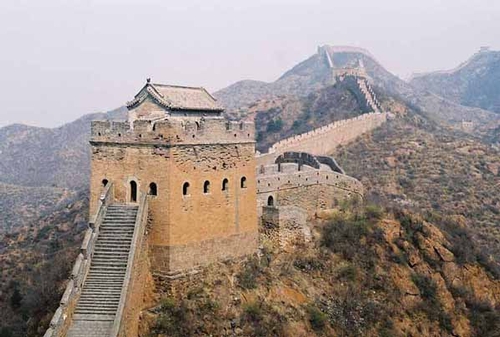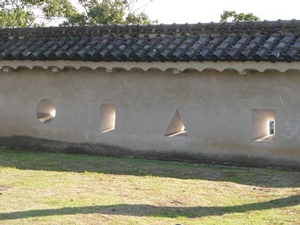The Great Wall and Himeji-Jo Castle are similar in that both of these iconic structures began as lesser forms of fortification. In addition, like many buildings over an extend period of time, both The Great Wall of China and Himeji-Jo Castle had to adapt over their existence.
The major parallel found here is that both structures endured an evolution from lesser forms out of necessity so that they were more effective at attempting to accomplish their purpose. The reasons causing the need for change included the shifting of power, and the advancement of technology. In addition, with both being such large undertakings, unorthodox resources were utilized to complete them, ranging from tea-stones to teams of men.
The Great Wall
The Great Wall of China began not as a planned undertaking to build a massive defensive wall, rather it began with walls from previous individual states (Geil, pg. 233). After King Qin Shihuang unified Chin and formed the Qin Dynasty in 221 B.C.E., he ordered that sections of walls in the warring states be torn down and have new walls built that unite the series into a singular fortification (Great Wall of China). Qin did this in order to create centralized rule and personify the concept of a unified China. The walls during this period were mostly rammed earth, however as the building intensified and warfare advanced the materials changed to counteract. The Great Wall that we know of today did not fully develop until the Ming Dynasty (Waldron, pg. 13). With the Mongols posing as a much larger threat to China then before, massive wall building initiatives took place using brick and stone. Like any building project, builders always tried to utilize the local resources available (Great Wall of China). However, given the massive scale of endeavor, resources from further away sources had to be employed as well. This did not exclude the builders themselves. Archeologists have unearthed the remains of workers who were buried inside the wall.
Himeji-jo Castle
Himeji-Jo Castle went through three stages of development until it became what it is today. It began with in 1346 by Akamatsu Sadanori who built what was more of a fortified building (Japanese Castles, pg. 121). It wasn’t until Hideyoshi was placed in charge of the structure with orders to make the site a strategic base to control western Japan, that the fortification became a castle. In 1601, Ikeda Terumasa assumed control of Himeji-jo and started a nine year building program that transformed the site into its current form. The expansion and renovation of the structure was such a large project that the stone sarcophagi from grave mounds of the Tumulus period, more than a millennium earlier, were used to build the walls. The demand for further stone was so great that according to a traditional account, “tea-leaf grindstones were reused in the base of the tenshu”: the central tower (Japanese Castles, pg. 87-87). The structure also had to be adapted for changes in warfare as well. As gunpowder based weapons became a more prominent weapon and troop movements became more disciplined, parts of Himeji were adapted to account for these changes (Orui, pg. 58). The outside walls of towers and other structures had loopholes cut into them, out of which the defenders shot projectiles. You can distinguish between which weapons were being used by the shape of the loopholes. Bows utilized rectangular loopholes whereas those for firearms were circular, triangular or sometimes square.


